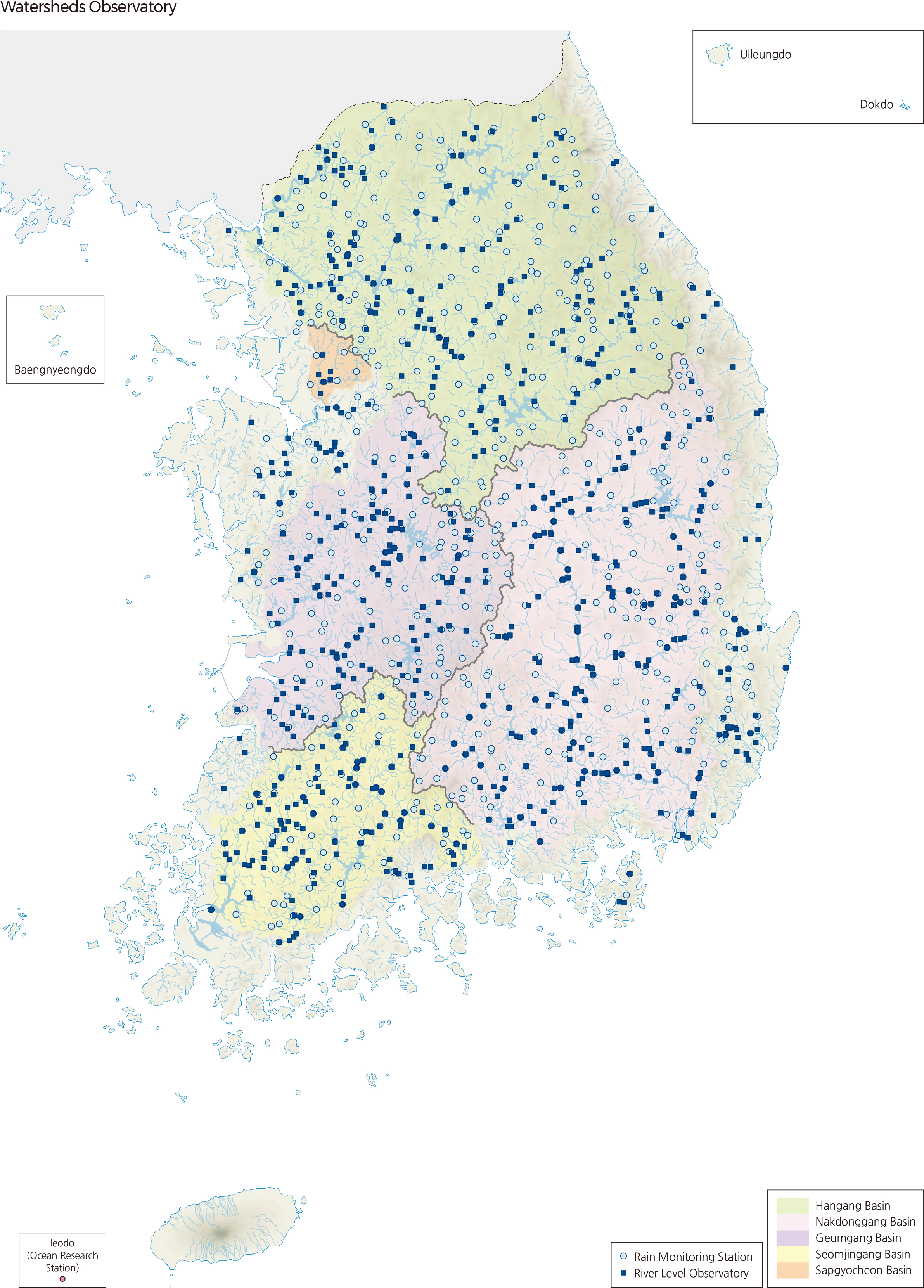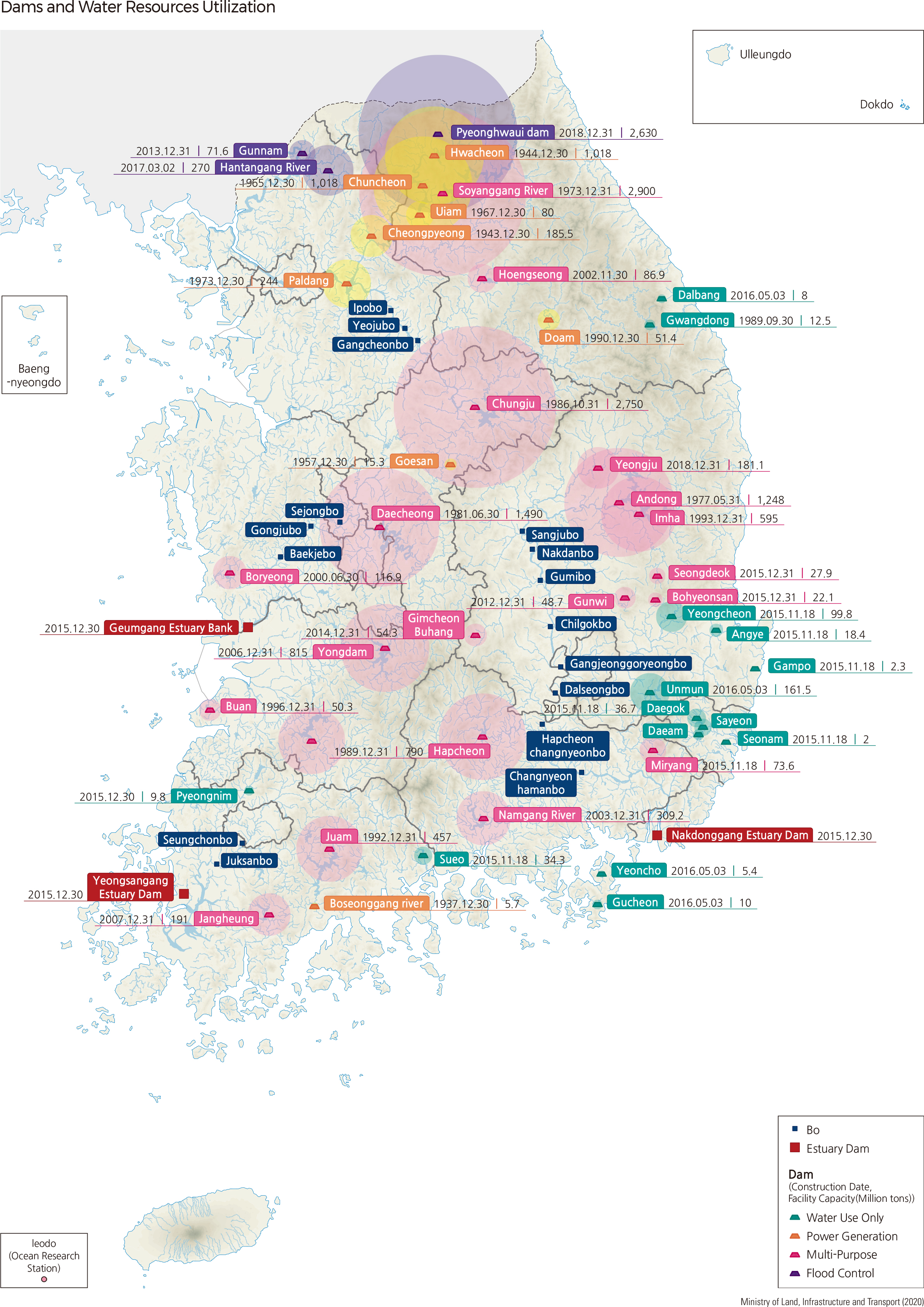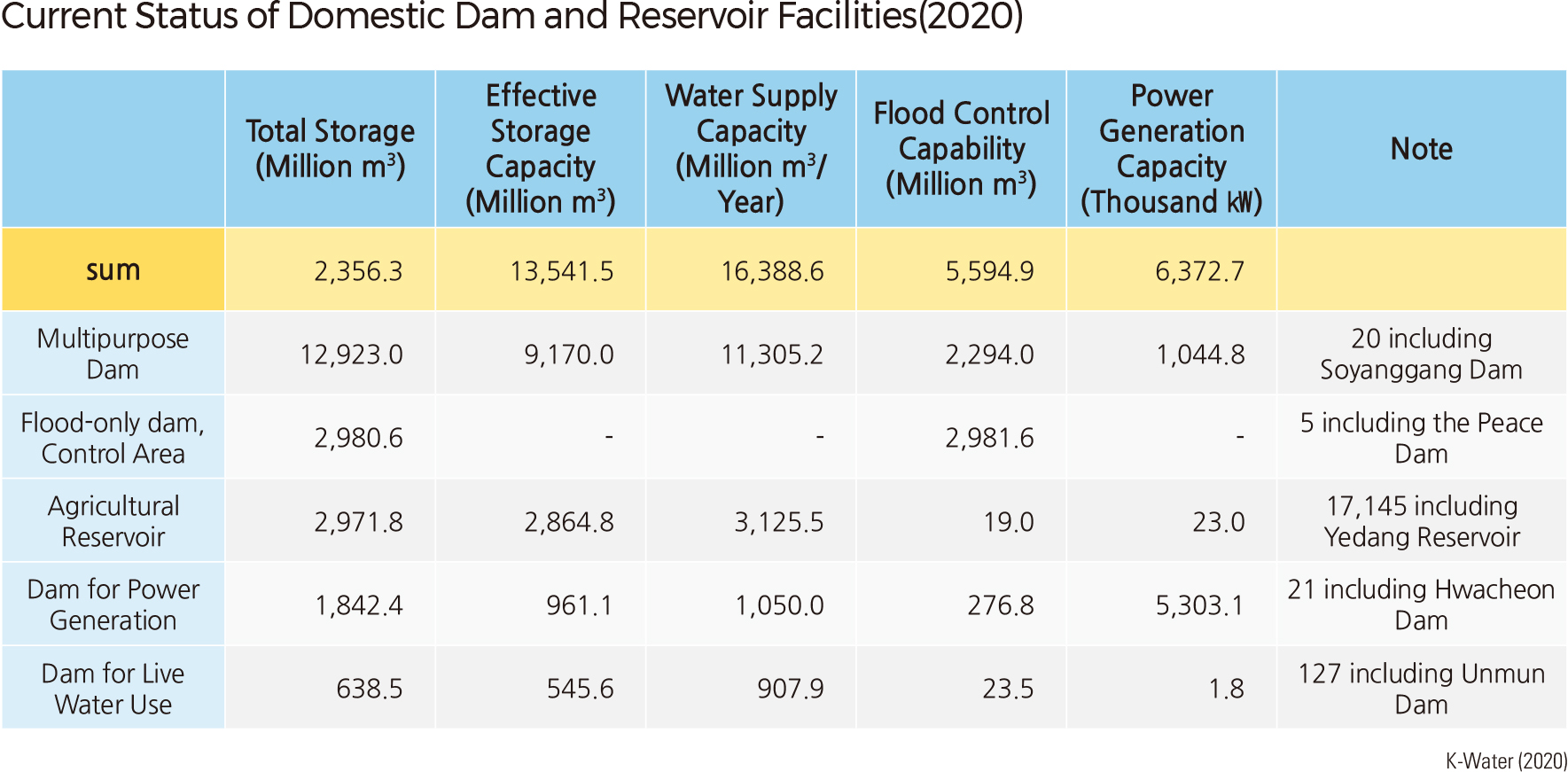English III 2021
Water played an important role in Korea’s urban and industrial development in the second half of the 20th century. Many cities and industrial facilities have grown around rivers rich in water, such as the Hangang and Nakdonggang. Therefore, Korea has put a lot of effort into making easy use of water resources, which are essential for economic development. The annual mean precipitation is 1,283 mm (1,054 mm in North Korea), higher than the global average (973 mm). There are significant annual and seasonal variations in precipitation. Topographic diversity brings a marked difference in precipitation. Since 2000, precipitation varied as little as 949 mm (2015), 967.8 mm (2017), 988.7 mm (2008), and as much as 1,622.6 (2011), 1470.6 mm (2002), and the ratio between the annual minimum and maximum precipitation reaches 1.7. By season, since 2000, 54% of annual precipitation has been concentrated in summer and only 7% in winter. In 2011, 1053.6 mm, or 67% of the annual precipitation, fell in summer, while only 3%, or 45.6 mm, fell in winter. Regional variations in annual precipitation are also large. In 2015, Daegu recorded 548.5 mm of precipitation, while Jeju received 2,108.8 mm. Of the total water resources of 132.3 billion m3, 43% is lost by evaporation, and 29% by surface runoff due to steep slopes and heavy downpours. Most of the runoff is concentrated during the flood season from June to September. The amount of runoff also has a wide variation, from the lowest of 40.6 billion m3 (1988) to the highest of 129.3 billion m3 (2003). As of 2016, groundwater use accounted for only 1.4% of the total facility capacity of 37,219,000 m2/day or 531,000 m2/day, and the intake capacity of river drift facilities was 18,521 m2/day, accounting for 49.8% of the total. Therefore, it calls for more sophisticated policies to efficiently manage water resources. Of the total water resources, only 28% are usable. Therefore, the central government has put much effort into water management to efficiently utilize the precipitation concentrated in a particular season by building dams. Currently, dams provide about 17% of water resources. The Framework Act on Water Management was enforced in June 2019, and the government is establishing a sustainable water management system. According to this Act, the National Water Management Committee under the jurisdiction of the President was launched on August 27, 2019. This committee consists of two co-chairs, a government representative (Prime Minister) and a private representative, seven ministers of water-resource management-related ministries (Minister of Finance, the Minister of Public Administration and Security, the Minister of Agriculture, Food and Rural Affairs, the Minister of Trade, Industry and Energy, the Minister of Environment, the Minister of Land, Infrastructure, and Transport, and the Minister of Oceans and Fisheries), the Minister of Office for Government Policy, the Commissioner of the Korea Meteorological Administration, and the Commissioner of the Korea Forest Service. The National Water Management Committee approved the 10 Year Master Plan for National Water Management prepared by the Minister of Environment. The first National Water Management Plan was implemented in June 2021. It is a high-level plan that provides the basic direction for all government policies related to water, such as Comprehensive Measures for Non-Point Pollution Source Management and the National Sewage Master Plan, and plans related to water resource use, such as the Long-Term Comprehensive Plan for Water Resources, the River Basin Water Resource Management Plan, and the Master Plan for Groundwater Management. In 2018, the total water use was estimated at 36.6 billion m3 (37.2 billion m3 in 2016): dams supplied 53.5% (20.39 billion m3) of the total water use, while river water supplied 35.0% (13.32 billion m3). The underground water is estimated at 20 billion m3. It is estimated that 13 billion m3 were developed, but only 2.91 billion m3 were used. Reuse water (1.11 billion m3), reclaimed sewage water (360 million m3), and rainwater (8 million m3) accounted for 2.8% of the total water use. About 1/3 (12.2 billion m3) of the total water use was used for river maintenance, and two-thirds (25.0 billion m3) was supplied for agricultural, domestic, and industrial purposes. Agricultural water accounted for 63% (15.4 billion m3) of water use, followed by domestic water 30% (7.4 billion m3) and industrial water 7% (1.6 billion m3). Agricultural water decreased from 16 billion m3 in 2003 and was maintained at 15.2 to 15.4 billion m3 after 2007. Domestic water shows little change from 7.6 billion m3 in 2003. Industrial water also showed no significant difference from 2.4 billion m3 in 1990 to 2.3 billion m3 in 2014. In 2018, as a new standard to classify purified water used for industrial purposes as domestic water was applied, the industrial water use became 1.6 billion m3. Water is mainly supplied through metropolitan or industrial waterworks operated by Korea Water Resources Corporation or local waterworks operated by local governments. In 2018, these two waterworks operated 503 water intake facilities (capacity of 32,861,000 m3/day) and 517 water purification facilities (capacity of 30,445,000 m3/day). The metropolitan or industrial waterworks operated 29 water intake facilities with a capacity of 13,916,000 m3/day, 42.3% of the total facility capacity, and 71 water purification facilities and 10,346,000 m3/day, which is 34% of the total facilities capacity. However, it operated a total length of 211,771 km of the water supply pipelines, accounting for 97.5% of the total (217,150 km). In addition, there are 14,933 village water supply facilities and small-scale facilities operating in areas where water supply is limited. The facility capacity is 1,361,000 m3/day, 4% of the total water intake capacity. Korea Hydro & Nuclear Power operates dams to generate electricity and supply water through Hwacheon Dam, Chuncheon Dam, Uiam Dam, Cheongpyeong Dam, and Paldang Dam through a joint operation council for dams and weirs in the Hangang river system. In particular, upstream of Paldang Dam supplies 1.3 billion tons of water for regional water supply and 3.9 billion tons of annual river maintenance water per year. City water of Chuncheon-si is provided from Yongsan intake (up to 53,000 tons/day) and Soyang intake (165,000 tons/day). |





